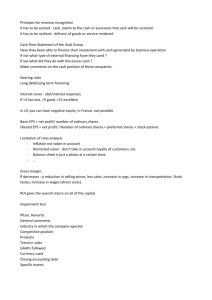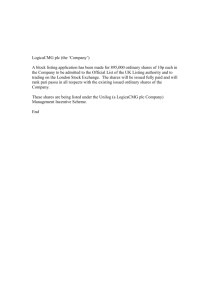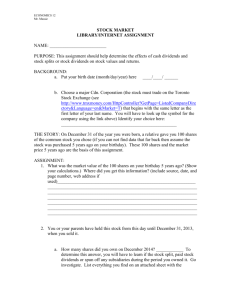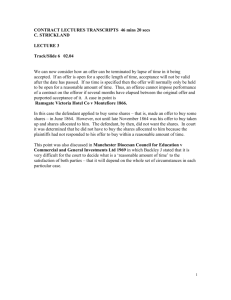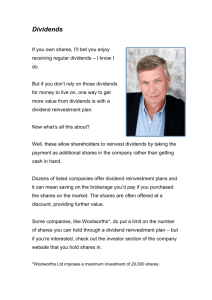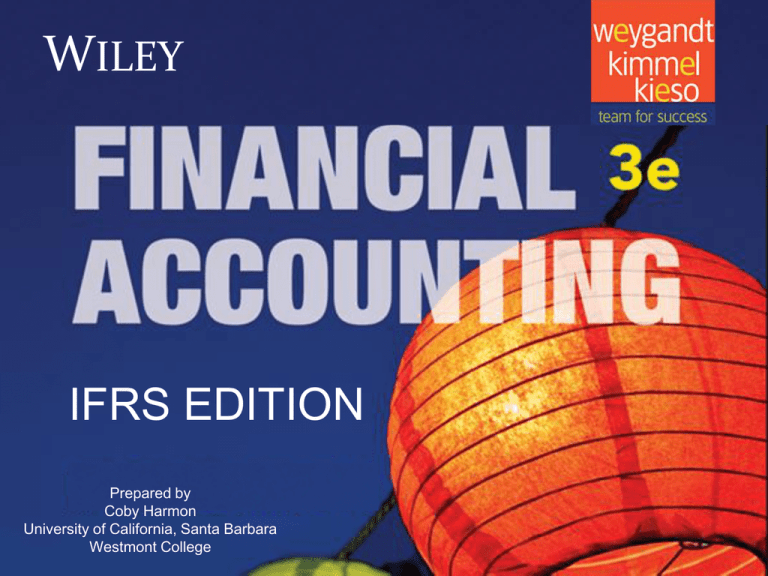
WILEY
IFRS EDITION
Prepared by
Coby Harmon
University of California, Santa Barbara
Westmont College
11-1
PREVIEW OF CHAPTER 11
Financial Accounting
IFRS 3rd Edition
Weygandt ● Kimmel ● Kieso
11-2
CHAPTER
11
Corporations: Organization,
Share Transactions, Dividends,
and Retained Earnings
LEARNING OBJECTIVES
After studying this chapter, you should be able to:
1. Identify the major characteristics of a corporation.
2. Record the issuance of ordinary shares.
3. Explain the accounting for treasury shares.
4. Differentiate preference shares from ordinary shares.
5. Prepare the entries for cash dividends and share dividends.
6. Identify the items reported in a retained earnings statement.
7. Prepare and analyze a comprehensive equity section.
11-3
The Corporate Form of Organization
Learning Objective 1
An entity separate and distinct
from its owners.
Classified by Ownership
Classified by Purpose
►
►
11-4
Identify the major
characteristics of a
corporation.
Not-for-Profit
Publicly held
For Profit
Privately held
Salvation Army
(USA)
International
Committee of the
Red Cross (CHE)
►
►
►
►
Toyota (JPN)
Siemens (DEU)
Sinopec (CHN)
General
Electric (USA)
►
Cargill Inc.
(USA)
LO 1
Characteristics of a Corporation
Characteristics that distinguish corporations from
proprietorships and partnerships.
11-5
Separate Legal Existence
Limited Liability of Shareholders
Transferable Ownership Rights
Ability to Acquire Capital
Continuous Life
Corporate Management
Government Regulations
Additional Taxes
Advantages
Disadvantages
LO 1
Characteristics of a Corporation
Characteristics that distinguish corporations from
proprietorships and partnerships.
11-6
Separate Legal Existence
Limited Liability of Shareholders
Transferable Ownership Rights
Ability to Acquire Capital
Continuous Life
Corporate Management
Government Regulations
Additional Taxes
Corporation acts
under its own name
rather than in the
name of its
shareholders.
LO 1
Characteristics of a Corporation
Characteristics that distinguish corporations from
proprietorships and partnerships.
11-7
Separate Legal Existence
Limited Liability of Shareholders
Transferable Ownership Rights
Ability to Acquire Capital
Continuous Life
Corporate Management
Government Regulations
Additional Taxes
Limited to their
investment.
LO 1
Characteristics of a Corporation
Characteristics that distinguish corporations from
proprietorships and partnerships.
11-8
Separate Legal Existence
Limited Liability of Shareholders
Transferable Ownership Rights
Ability to Acquire Capital
Continuous Life
Corporate Management
Government Regulations
Additional Taxes
Shareholders may
sell their shares.
LO 1
Characteristics of a Corporation
Characteristics that distinguish corporations from
proprietorships and partnerships.
11-9
Separate Legal Existence
Limited Liability of Shareholders
Transferable Ownership Rights
Ability to Acquire Capital
Continuous Life
Corporate Management
Government Regulations
Additional Taxes
Corporation can
obtain capital
through the issuance
of shares.
LO 1
Characteristics of a Corporation
Characteristics that distinguish corporations from
proprietorships and partnerships.
11-10
Separate Legal Existence
Limited Liability of Shareholders
Transferable Ownership Rights
Ability to Acquire Capital
Continuous Life
Corporate Management
Government Regulations
Additional Taxes
Continuance as a
going concern is not
affected by the
withdrawal, death, or
incapacity of a
shareholder,
employee, or officer.
LO 1
Characteristics of a Corporation
Characteristics that distinguish corporations from
proprietorships and partnerships.
11-11
Separate Legal Existence
Limited Liability of Shareholders
Transferable Ownership Rights
Ability to Acquire Capital
Continuous Life
Corporate Management
Government Regulations
Additional Taxes
Separation of
ownership and
management
prevents owners
from having an
active role in
managing the
company.
LO 1
Characteristics of a Corporation
Characteristics that distinguish corporations from
proprietorships and partnerships.
11-12
Separate Legal Existence
Limited Liability of Shareholders
Transferable Ownership Rights
Ability to Acquire Capital
Continuous Life
Corporate Management
Government Regulations
Additional Taxes
Government
regulations are
designed to protect
the owners of the
corporation.
LO 1
Characteristics of a Corporation
Characteristics that distinguish corporations from
proprietorships and partnerships.
11-13
Separate Legal Existence
Limited Liability of Shareholders
Transferable Ownership Rights
Ability to Acquire Capital
Continuous Life
Corporate Management
Government Regulations
Additional Taxes
Corporations pay
income taxes as a
separate legal entity
and in addition,
shareholders pay
taxes on cash
dividends.
LO 1
Characteristics of a Corporation
Shareholders
Illustration 11-1
Corporation organization chart
Chairman and
Board of
Directors
President and
Chief Executive
Officer
General
Counsel and
Secretary
Vice President
Marketing
Treasurer
11-14
Vice President
Finance/Chief
Financial Officer
Vice President
Operations
Vice President
Human
Resources
Controller
LO 1
Forming a Corporation
Initial Steps:
File application with governmental agency in the
jurisdiction in which incorporation is desired.
Government grants charter.
Corporation develops by-laws.
Companies incorporate in a state or country whose laws are
favorable to the corporate form of business.
Corporations expense organization costs as incurred.
11-15
LO 1
Ownership Rights of Shareholders
Shareholders have the right to:
1. Vote in election of board of
directors and on actions that
require shareholder approval.
2. Share the corporate earnings
through receipt of dividends.
Illustration 11-3
Ownership rights of shareholders
11-16
LO 1
Ownership Rights of Shareholders
Shareholders have the right to:
Illustration 11-3
Ownership rights of shareholders
3. Keep the same percentage ownership when new
shares are issued (preemptive right*).
* A number of companies have eliminated the preemptive right.
11-17
LO 1
Ownership Rights of Shareholders
Shareholders have the right to:
4. Share in assets upon liquidation in proportion to
their holdings. This is called a residual claim.
Illustration 11-3
Ownership rights of shareholders
11-18
LO 1
Ownership Rights of Shareholders
Illustration 11-4
A share certificate
Prenumbered
PAR VALUE
$1 PER SHARE
PAR VALUE
$1 PER SHARE
Name of corporation
Shareholder’s name
Bill Harmon
Shares
Signature of corporate
official
11-19
LO 1
Share Issue Considerations
AUTHORIZED SHARES
11-20
Charter indicates the amount of shares that a
corporation is authorized to sell.
Number of authorized shares is often reported in the
equity section.
LO 1
Share Issue Considerations
ISSUANCE OF SHARES
Corporation can issue ordinary shares directly to investors
or indirectly through an investment banking firm.
Factors in setting price for a new issue of shares:
1. Company’s anticipated future earnings.
2. Expected dividend rate per share.
3. Current financial position.
4. Current state of the economy.
5. Current state of the securities market.
11-21
LO 1
Share Issue Considerations
MARKET PRICE OF SHARES
11-22
Shares of publicly held companies is traded on organized
exchanges.
Interaction between buyers and sellers determines the
prices per share.
Prices tend to follow the trend of a company’s earnings and
dividends.
Factors beyond a company’s control may cause day-to-day
fluctuations in market prices.
LO 1
Investor Insight
How to Read Share Quotes
Organized exchanges trade the shares of publicly held companies at prices
per share established by the interaction between buyers and sellers. For each
listed security, the financial press reports the high and low prices of the shares
during the year, the total volume of shares traded on a given day, the high and
low prices for the day, and the closing market price, with the net change for the
day. adidas (DEU) is listed on a number of exchanges. Here is a listing for
adidas (prices are in euros).
These numbers indicate the following. The high and low market prices for the
previous 52 weeks were €57.62 and €42.41. The trading volume for the day
was 1,080,000 shares. The high, low, and closing prices for that date were
€52.50, €50.77, and €50.79, respectively. The net change for the day was a
decrease of €1.081 per share.
11-23
LO 1
Share Issue Considerations
PAR AND NO-PAR VALUE SHARES
11-24
Years ago, par value determined the legal capital per share
that a company must retain in the business for the
protection of corporate creditors.
Today many governments do not require a par value.
No-par value shares are fairly common today.
In many countries the board of directors assigns a stated
value to no-par shares.
LO 1
Share Issue Considerations
Question
Which of the following statements is false?
a. Ownership of ordinary shares gives the owner a
voting right.
b. The equity section begins with a share capital
section.
c. The authorization of share capital does not result in a
formal accounting entry.
d. Par value and market price of a company’s shares
are always the same.
11-25
LO 1
>
DO IT!
Indicate whether each of the following statements is true or false.
1. Similar to partners in a partnership, shareholders of
a corporation have unlimited liability.
False
2. It is relatively easy for a corporation to obtain capital
through the issuance of shares.
True
3. The separation of ownership and management is an
advantage of the corporate form of business.
False
4. The journal entry to record the authorization of
ordinary shares includes a credit to the appropriate
share capital account.
False
11-26
LO 1
Corporate Capital
Equity is identified by various names:
stockholders’ equity,
shareholders’ equity, or
corporate capital.
The equity section of a corporation’s statement of financial
position consists of two parts:
1. share capital and
2. retained earnings (earned capital).
11-27
LO 1
Corporate Capital
Illustration 11-5
Equity section
11-28
LO 1
Corporate Capital
Comparison of the equity accounts for a proprietorship, and
a corporation.
Illustration 11-6
Comparison of equity accounts
11-29
LO 1
People, Planet, and Profit Insight
The Impact of Corporate Social Responsibility
A recent survey conducted by Institutional Shareholder Services, a U.S. proxy
advisory firm, shows that 83% of investors now believe environmental and
social factors can have a significant impact on shareholder value over the
long term. This belief is clearly visible in the rising level of support for
shareholder proposals requesting action related to social and environmental
issues. The following table shows that the number of corporate social
responsibility (CSR)-related shareholder proposals rose from 150 in 2000 to
191 in 2010. Moreover, those proposals garnered average voting support of
18.4% of votes cast versus just 7.5% a decade earlier.
Source: Investor Responsibility Research Center, Ernst & Young, Seven Questions
CEOs and Boards Should Ask About: “Triple Bottom Line” Reporting.
11-30
LO 1
>
DO IT!
At the end of its first year of operation, Doral AG has €750,000 of
ordinary share and net income of €122,000. Prepare (a) the
closing entry for net income and (b) the equity section at year-end.
(a)
(b)
11-31
Income Summary
Retained Earnings
Equity
Share capital—ordinary
Retained earnings
Total equity
122,000
122,000
€750,000
122,000
€872,000
LO 1
Accounting for Ordinary Share Issues
ISSUING PAR VALUE ORDINARY
SHARES FOR CASH
Learning Objective 2
Record the issuance of
ordinary shares.
Illustration: Hydro-Slide SA issues 1,000 shares of €1 par value
ordinary shares. Prepare Hydro-Slide’s journal entry if (a)
1,000 shares are issued for €1 per share, and (b) 1,000 shares
are issued for €5 per share.
a)
Cash
1,000
Share Capital—Ordinary (1,000 x €1)
b)
11-32
Cash
1,000
5,000
Share Capital—Ordinary (1,000 x €1)
1,000
Share Premium—Ordinary
4,000
LO 2
PAR VALUE ORDINARY SHARES
Illustration 11-7
Share premium
11-33
LO 2
Accounting for Ordinary Share Issues
ISSUING NO-PAR ORDINARY SHARES FOR CASH
Illustration: Assume that Hydro-Slide SA issues 5,000 shares of
€5 stated value no-par shares for €8 per share. The entry is:
Cash
40,000
Share Capital—Ordinary (5,000 x €5)
25,000
Share Premium—Ordinary
15,000
Prepare the entry assuming there is no stated value.
Cash
Share Capital—Ordinary
11-34
40,000
40,000
LO 2
Accounting for Ordinary Share Issues
ISSUING ORDINARY SHARES FOR SERVICES
OR NON-CASH ASSETS
Corporations also may issue shares for:
Services (attorneys or consultants).
Noncash assets (land, buildings, and equipment).
Cost is either the fair market value of the consideration given up, or the
fair market value of the consideration received, whichever is more
clearly determinable.
11-35
LO 2
ISSUING ORDINARY SHARES FOR
SERVICES OR NON-CASH ASSETS
Illustration: Assume that attorneys have helped Jordan Company
incorporate. They have billed the company €5,000 for their
services. They agree to accept 4,000 shares of €1 par value
shares in payment of their bill. At the time of the exchange,
there is no established market price for the shares. Prepare the
journal entry for this transaction.
Organization Expense
11-36
5,000
Share Capital—Ordinary
4,000
Share Premium—Ordinary
1,000
LO 2
ISSUING ORDINARY SHARES FOR
SERVICES OR NON-CASH ASSETS
Illustration: Assume that Athletic Research Inc. is an existing
publicly held corporation. Its €5 par value shares are actively
traded at €8 per share. The company issues 10,000 shares to
acquire land recently advertised for sale at €90,000. Prepare
the journal entry for this transaction.
Land
11-37
80,000
Share Capital—Ordinary
50,000
Share Premium—Ordinary
30,000
LO 2
ANATOMY OF A FRAUD
The president, chief operating officer, and chief financial officer of SafeNet (USA), a
software encryption company, were each awarded employee share options by the
company’s board of directors as part of their compensation package. Share options enable
an employee to buy a company’s shares sometime in the future at the price that existed
when the share option was awarded. For example, suppose that you received share
options today, when the share price of your company was $30. Three years later, if the
share price rose to $100, you could “exercise” your options and buy the shares for $30 per
share, thereby making $70 per share. After being awarded their share options, the three
employees changed the award dates in the company’s records to dates in the past, when
the company’s shares were trading at historical lows. For example, using the previous
example, they would choose a past date when the shares were selling for $10 per share,
rather than the $30 price on the actual award date. In our example, this would increase the
profit from exercising the options to $90 per share.
Total take: $1.7 million
The Missing Control
Independent internal verification. The company’s board of directors should have ensured
that the awards were properly administered. For example, the date on the minutes from the
board meeting could be compared to the dates that were recorded for the awards. In addition,
the dates should again be confirmed upon exercise.
11-38
LO 2
>
DO IT!
Hefei Ltd. begins operations on March 1 by issuing 1,000,000 ¥10 par
value ordinary shares for cash at ¥12 per share. On March 15, it issues
50,000 ordinary shares to attorneys in settlement of their bill of
¥600,000 for organization costs. Journalize the issuance of the shares,
assuming the shares are not publicly traded.
Mar. 1
Cash
Share Capital—Ordinary
Share Premium—Ordinary
12,000,000
Mar. 15 Organization Expense
Share Capital—Ordinary
Share Premium—Ordinary
600,000
11-39
10,000,000
2,000,000
500,000
100,000
LO 2
Accounting for Treasury Shares
Treasury shares are a corporation’s own
shares that it has reacquired from
shareholders but not retired.
Learning Objective 3
Explain the accounting for
treasury shares.
Corporations purchase their outstanding shares to:
1. Reissue the shares to officers and employees under bonus
and share compensation plans.
2. Enhance the share’s market value.
3. Have additional shares available for use in the acquisition of
other companies.
4. Increase earnings per share.
5. Eliminate hostile shareholders by buying them out.
11-40
LO 3
Accounting for Treasury Shares
PURCHASE OF TREASURY SHARES
11-41
Debit Treasury Shares for the price paid to reacquire
the shares (cost method).
Treasury Shares is a contra equity account, not an
asset.
Purchase of treasury shares reduces equity.
LO 3
Accounting for Treasury Shares
Illustration 11-8
Equity section with no
treasury shares
Illustration: On February 1, 2017, Mead acquires 4,000 shares of its
stock at HK$80 per share.
Treasury Shares (4,000 x HK$80)
Cash
11-42
320,000
320,000
LO 3
Accounting for Treasury Shares
Equity Section with Treasury Shares
Illustration 11-9
Both the number of shares issued (100,000), outstanding (96,000),
and the number of shares held as treasury (4,000) are disclosed.
11-43
LO 3
Accounting for Treasury Shares
Question
In the statement of financial position, the cost of treasury
shares is deducted in:
a. expenses.
b. revenues.
c. equity.
d. liabilities.
11-44
LO 3
Accounting Across the Organization
Why Would a Company Buy Its Own Shares?
In a bold (and some would say risky) move, Reebok (DEU) at one time bought
back nearly a third of its shares. This repurchase of shares dramatically
reduced Reebok’s available cash. In fact, the company borrowed significant
funds to accomplish the repurchase. In a press release, management stated
that it was repurchasing the shares because it believed its shares were
severely underpriced. The repurchase of so many shares was meant to signal
management’s belief in good future earnings. Skeptics, however, suggested
that Reebok’s management was repurchasing shares to make it less likely that
another company would acquire Reebok (in which case Reebok’s top
managers would likely lose their jobs). By depleting its cash, Reebok became
a less likely acquisition target. Acquiring companies like to purchase
companies with large cash balances so they can pay off debt used in the
acquisition. As noted in the Feature Story, Reebok was eventually acquired by
adidas (DEU). In 2014, adidas announced a program to buy back up to 10% of
its shares. This was done to appease shareholders who were disappointed
with the company’s results in recent years.
11-45
LO 3
Accounting for Treasury Shares
DISPOSAL OF TREASURY SHARES
Sale of Treasury Shares
Above Cost
Below Cost
Both increase total assets and equity.
11-46
LO 3
Accounting for Treasury Shares
Above
Cost
Illustration: On July 1, Mead sells for HK$100 per share 1,000
shares of its treasury shares, previously acquired at HK$80 per
share.
July 1 Cash
100,000
Treasury Shares (1,000 x HK$80)
80,000
Share Premium—Treasury
20,000
A corporation does not realize a gain or suffer a loss from share
transactions with its own shareholders.
11-47
LO 3
Accounting for Treasury Shares
Below
Cost
Illustration: On Oct. 1, Mead sells an additional 800 treasury
shares at HK$70 per share.
Oct. 1 Cash
Share Premium—Treasury
Treasury Shares (800 x HK$80)
56,000
8,000
64,000
Illustration 11-10
11-48
LO 3
Accounting for Treasury Shares
Below
Cost
Illustration: On Dec. 1, assume that Mead, Inc. sells its
remaining 2,200 shares at HK$70 per share.
Dec. 1 Cash
Share Premium—Treasury
12,000
Retained Earnings
10,000
Treasury Shares
11-49
154,000
Limited
to
balance
on hand
176,000
LO 3
>
DO IT!
Salvador SA purchases 3,000 shares of its R$50 par value ordinary
shares for R$180,000 cash on July 1. It will hold the shares in the
treasury until resold. On November 1, the corporation sells 1,000
treasury shares for cash at R$70 per share. Journalize the treasury
share transactions.
July 1
Nov. 1
11-50
Treasury Shares
Cash
Cash
Treasury Shares
Share Premium—Treasury
180,000
180,000
70,000
60,000
10,000
LO 3
Accounting for Preference Shares
Typically, preference shareholders have
a priority as to
Learning Objective 4
Differentiate preference
shares from ordinary
shares.
1. distributions of earnings (dividends) and
2. assets in the event of liquidation.
Accounting for preference shares at issuance is similar to that for
ordinary shares.
11-51
LO 4
Accounting for Preference Shares
Illustration: Stine Corporation issues 10,000 shares of €10 par
value preference shares for €12 cash per share. Journalize the
issuance of the preference shares.
Cash
120,000
Share Capital—Preference (10,000 x €10)
100,000
Share Premium—Preference
20,000
Preference shares may have a par value or no-par value.
11-52
LO 4
Accounting for Preference Shares
DIVIDEND PREFERENCES
Right to receive dividends before ordinary shareholders.
Cumulative Dividend – preference shareholders must be
paid both current-year dividends and any unpaid prior-year
dividends before ordinary shareholders receive dividends.
No obligation exists until board of directors declares a
dividend.
11-53
Liquidation preference.
LO 4
Accounting for Preference Shares
CUMULATIVE DIVIDEND
Illustration: Scientific Leasing has 5,000 shares of 7%, €100 par
value, cumulative preference shares outstanding. Each €100
share pays a €7 dividend (.07 x €100). The annual dividend is
€35,000 (5,000 x €7 per share). If dividends are two years in
arrears, preference shareholders are entitled to receive the
following dividends in the current year.
11-54
Illustration 11-11
Computation of total dividends to preference shares
LO 4
Accounting for Preference Shares
LIQUIDATION PREFERENCES
Most preference shares have a preference on corporate
assets if the corporation fails.
Provides security for the preference shareholder.
Preference to assets may be for the par value of the
shares or for a specified liquidating value.
11-55
LO 4
The Corporate Form of Organization
Learning Objective 5
Distribution of cash or shares to
shareholders on a pro rata (proportional)
basis.
Prepare the entries for
cash dividends and share
dividends.
Types of Dividends:
1. Cash
3. Shares
2. Property
4. Scrip
Dividends expressed: (1) as a percentage of the par or stated
value, or (2) as a dollar amount per share.
11-56
LO 5
Cash Dividends
Three dates:
11-57
Illustration 11-12
Key dividend dates
LO 5
Cash Dividends
For a corporation to pay a cash dividend, it must have:
1. Retained earnings - Payment of cash dividends from
retained earnings is legal in all jurisdictions.
2. Adequate cash.
3. A declaration of dividends by the Board of Directors.
11-58
LO 5
ENTRIES FOR CASH DIVIDENDS
Illustration: On Dec. 1, the directors of Media General declare a
€.50 per share cash dividend on 100,000 shares of €10 par value
ordinary shares. The dividend is payable on Jan. 20 to
shareholders of record on Dec. 22.
December 1 (Declaration Date)
Cash Dividends
Dividends Payable
December 22 (Date of Record)
50,000
50,000
No entry
January 20 (Payment Date)
Dividends Payable
Cash
11-59
50,000
50,000
LO 5
Cash Dividends
ALLOCATING CASH DIVIDENDS BETWEEN
PREFERENCE AND ORDINARY SHARES
Holders of cumulative preference shares must be paid any
unpaid prior-year dividends before ordinary shareholders
receive dividends.
11-60
LO 5
Cash Dividends
Illustration: On December 31, 2017, IBR Inc. has 1,000 shares of
8%, €100 par value cumulative preference shares. It also has
50,000 shares of €10 par value ordinary shares outstanding. At
December 31, 2017, the directors declare a €6,000 cash dividend.
Prepare the entry to record the declaration of the dividend.
Cash Dividends
Dividends Payable
6,000
6,000
Preference Dividends: 1,000 shares x €100 par x 8% = €8,000
11-61
LO 5
Cash Dividends
Illustration: At December 31, 2018, IBR declares a €50,000 cash
dividend. The allocation of the dividend to the two classes of
shares is as follows:
Illustration 11-13
Allocating dividends to preference and ordinary shares
11-62
LO 5
Cash Dividends
Illustration: At December 31, 2018, IBR declares a €50,000 cash
dividend. Prepare the entry to record the declaration of the
dividend.
Cash Dividends
Dividends Payable
11-63
50,000
50,000
LO 5
Share Dividends
Pro rata distribution of the corporation’s own shares.
Illustration 11-14
Effect of stock split
for shareholders
Results in decrease in retained earnings and
increase share capital and share premium.
11-64
LO 5
Share Dividends
Reasons why corporations issue share dividends:
1. Satisfy shareholders’ dividend expectations without
spending cash.
2. Increase marketability of the corporation’s shares.
3. Emphasize a portion of equity has been permanently
reinvested in the business.
11-65
LO 5
Share Dividends
Small share dividend (less than 20–25% of the
corporation’s issued shares, recorded at fair market
value) *
Large share dividend (greater than 20–25% of issued
shares, recorded at par value)
* Accounting based on the assumption that a small share dividend
will have little effect on the market price of the outstanding shares.
11-66
LO 5
Share Dividends
Illustration: Danshui Ltd. has a balance of NT$3,000,000 in retained
earnings. It declares a 10% share dividend on its 50,000 shares of
NT$100 par value ordinary shares. The current fair market value of
its shares is NT$150 per share.
10% share dividend is declared
Share Dividends (50,000 x 10% x NT$150)
Ordinary Share Dividends Distributable
Share Premium—Ordinary
750,000
500,000
250,000
Shares issued
Ordinary Share Dividends Distributable
500,000
Share Capital—Ordinary (50,000 x 10% x NT$100)
500,000
11-67
LO 5
Share Dividends
Statement Presentation
Illustration 11-15
Statement presentation of ordinary shares dividends distributable
11-68
LO 5
Share Dividends
EFFECTS OF SHARE DIVIDENDS
Illustration 11-16
Share dividend effects
11-69
LO 5
Share Dividends
Question
Which of the following statements about small share
dividends is true?
a. A debit to Retained Earnings for the par value of the
shares issued should be made.
b. A small share dividend decreases total equity.
c. Market price per share should be assigned to the
dividend shares.
d. A small share dividend ordinarily will have an effect
on par value per share.
11-70
LO 5
Share Splits
11-71
Reduces the market value of shares.
No entry recorded for a share split.
Decrease par value and increase number of shares.
LO 5
Share Splits
Illustration: Assume Danshui Ltd. splits its 50,000 ordinary
shares on a 2-for-1 basis.
Illustration 11-17
Share split effects
11-72
Results in a reduction of the par or stated value
per share.
LO 5
Investor Insight
A No-Split Philosophy
Warren Buffett’s company, Berkshire Hathaway (USA), has two classes
of shares. Until recently, the company had never split either class of
shares. As a result, the class A shares had a market price of $97,000 and
the class B sold for about $3,200 per share. Because the price per share
is so high, the shares do not trade as frequently as the shares of other
companies. Mr. Buffett has always opposed share splits because he feels
that a lower share price attracts short-term investors. He appears to be
correct. For example, while more than 6 million shares of IBM (USA) are
exchanged on the average day, only about 1,000 class A shares of
Berkshire are traded. Despite Mr. Buffett’s aversion to splits, in order to
accomplish a recent acquisition, Berkshire decided to split its class B
shares 50 to 1.
Source: Scott Patterson, “Berkshire Nears Smaller Baby B’s,” Wall Street Journal
Online (January 19, 2010).
11-73
LO 5
>
DO IT!
The market price of Sing CD Company’s 500,000 shares of £2 par value
ordinary shares is £45. President Joan Elbert is considering either a 10%
share dividend or a 2-for-1 share split. She asks you to show the beforeand-after effects of each option on retained earnings, total equity, total
shares outstanding, and par value per share.
Share dividend amount is £2,250,000 [(500,000 × 10%) × £45].
11-74
LO 5
Retained Earnings
Learning Objective 6
Identify the items reported
in a retained earnings
statement.
Net income increases Retained
Earnings and a net loss decreases
Retained Earnings.
Part of the shareholders’ claim on the total assets of
the corporation.
Debit balance in Retained Earnings is identified as a
deficit.
Illustration 11-20
Equity with deficit
11-75
LO 6
Retained Earnings Restrictions
Restrictions can result from:
1. Legal restrictions.
2. Contractual restrictions.
3. Voluntary restrictions.
Companies generally disclose retained earnings restrictions in
the notes to the financial statements.
11-76
LO 6
Prior Period Adjustments
Correction of an error in previously issued financial
statements.
Result from:
11-77
►
mathematical mistakes.
►
mistakes in application of accounting principles.
►
oversight or misuse of facts.
Adjustment made to the beginning balance of retained
earnings.
LO 6
>
DO IT!
Chen Ltd. has retained earnings of ¥5,130,000 on January 1, 2017.
During the year, Chen earned ¥2,000,000 of net income. It declared
and paid a ¥250,000 cash dividend. In 2017, Chen recorded an
adjustment of ¥180,000 due to the understatement (from a
mathematical error) of 2016 depreciation expense. Prepare a
corrected retained earnings statement for 2017.
Chen Ltd.
Retained Earnings Statement
For the Year Ended December 31, 2017
Balance, January 1
Add: Net income
Less: Dividends
Balance, December 31
11-78
¥5,130,000
2,000,000
250,000
¥6,880,000
LO 6
>
DO IT!
In 2017, Chen recorded an adjustment of ¥180,000 due to the
understatement (from a mathematical error) of 2016 depreciation
expense. Prepare a retained earnings statement for 2017.
Chen Ltd.
Retained Earnings Statement
For the Year Ended December 31, 2017
Balance, January 1
Correction for overstatemet of net income in
prior period (depreciation error)
Balance, January 1, as adjusted
Add: Net income
Less: Dividends
Balance, December 31
11-79
¥5,130,000
-180,000
4,950,000
2,000,000
250,000
¥6,700,000
LO 6
Retained Earnings Statement
Debits and Credits to Retained Earnings
Illustration 11-23
Debits and credits to retained earnings
11-80
LO 6
Retained Earnings Statement
Question
All but one of the following is reported in a retained earnings
statement. The exception is:
a. cash and share dividends.
b. net income and net loss.
c. sales revenue.
d. prior period adjustments.
11-81
LO 6
Statement Presentation and Analysis
Presentation
11-82
Illustration 11-25
Comprehensive equity section
Learning Objective 7
Prepare and analyze a
comprehensive equity section.
LO 7
Statement Presentation and Analysis
Analysis
Carrefour’s beginning-of-the-year and end-of-the-year
ordinary shareholders’ equity were €8,047 and €8,597 million,
respectively. Its net income was €1,263 million, and no
preference shares were outstanding. The return on ordinary
shareholders’ equity is computed as follows.
Illustration 11-27
Return on ordinary shareholders’ equity and computation
11-83
LO 7
>
DO IT!
On January 1, 2017, Busan Ltd. purchased 2,000,000 treasury shares.
Other information regarding Busan is provided. (All amounts in thousands.)
Net income
Dividends on preference shares
Dividends on ordinary shares
2016
2017
₩110,000
₩110,000
₩10,000
₩10,000
₩2,000
₩1,600
Ordinary shareholders’ equity, beginning of year ₩500,000
₩400,000*
Ordinary shareholders’ equity, end of year
₩400,000
₩500,000
*Adjusted for purchase of treasury shares.
Compute return on ordinary shareholders’ equity for each year.
11-84
LO 7
APPENDIX 11A
Statement of Changes in Equity
Learning Objective 8
Illustration 11A-1
Statement of changes in equity
Describe the use and content of
the statement of changes in equity.
When a statement of changes in equity is presented, a retained
earnings statement is not necessary.
11-85
LO 8
APPENDIX 11B
Book Value—Another per Share Amount
Book Value per Share
Learning Objective 9
Compute book value per share.
The equity an ordinary shareholder has in the net assets of the
corporation.
Illustration 11B-1
Book value per share formula
11-86
LO 9
Book Value per Share
The computation of book value per share involves the following
steps.
1. Compute the preference share equity. This equity is equal
to the sum of the call price of preference shares plus any
cumulative dividends in arrears. If the preference shares do
not have a call price, the par value of the shares is used.
2. Determine the ordinary shareholders’ equity. Subtract the
preference share equity from total equity.
3. Determine book value per share. Divide ordinary
shareholders’ equity by ordinary shares.
11-87
LO 9
Book Value per Share
EXAMPLE
Illustration: Using the equity section of Graber SA shown in
Illustration 11-25. Graber’s preference shares are callable at €120
per share and are cumulative. Assume that dividends on Graber’s
preference shares were in arrears for one year, €54,000 (6,000 x
€9). The computation of preference share equity (Step 1 in the
preceding list) is:
Illustration 11B-2
Computation of preference share equity—Step 1
11-88
LO 9
Book Value per Share
Illustration 11B-2
Computation of book value:
Illustration 11B-3
Computation of book value per share with preference shares— Steps 2 and 3
11-89
LO 9
Book Value versus Market Value
The correlation between book value and the annual range of a
company’s market value per share is often remote.
Illustration 11B-4
Book value and market price compared
11-90
LO 9
A Look at U.S. GAAP
Key Points
11-91
Learning Objective 10
Compare the accounting for
equity under IFRS and U.S.
GAAP.
Many countries have a different mix of investor groups than in the United
States. For example, in Germany, financial institutions like banks are not
only major creditors of corporations but often are the largest corporate
shareholders as well. In the United States, Asia, and the United Kingdom,
many companies rely on substantial investment from private investors.
There are often terminology differences for equity accounts.
LO 10
A Look at U.S. GAAP
Key Points
Equity is given various descriptions under IFRS, such as shareholders’
equity, owners’ equity, capital and reserves, and shareholders’ funds.
Similarities
11-92
The accounting related to prior period adjustment is essentially the same
under IFRS and GAAP. IFRS addresses the accounting for errors in IAS 8
(“Accounting Policies, Changes in Accounting Estimates, and Errors”). One
area where IFRS and GAAP differ in reporting relates to error corrections in
previously issued financial statements. While IFRS requires restatement
with some exceptions, GAAP does not permit any exceptions.
LO 10
A Look at U.S. GAAP
Key Points
Similarities
11-93
The income statement using IFRS and GAAP is presented in a one- or twostatement format. The single-statement approach includes all items of
income and expense, as well as each component of other comprehensive
income or loss by its individual characteristic. In the two-statement
approach, a traditional income statement is prepared. It is then followed by
a statement of comprehensive income, which starts with net income or loss
and then adds other comprehensive income or loss items. Regardless of
which approach is reported, income tax expense is required to be reported.
The computations related to earnings per share are essentially the same
under IFRS and GAAP.
LO 10
A Look at U.S. GAAP
Key Points
Differences
11-94
As indicated in the chapter, under IFRS, the term reserves is used to
describe all equity accounts other than those arising from contributed (paidin) capital. This would include, for example, reserves related to retained
earnings, asset revaluations, and fair value differences.
GAAP has always discouraged the use of the term “Reserves” in any
context. Under GAAP, comprehensive income items are reported in the
equity section of the statement of financial position in a line labeled
accumulated other comprehensive income.
LO 10
A Look at U.S. GAAP
Key Points
Differences
11-95
The accounting for treasury shares differs somewhat between IFRS and
GAAP. However, many of the differences are beyond the scope of this
course. Like IFRS, GAAP does not allow a company to record gains or
losses on purchases of its own shares. One difference worth noting is that,
when a company purchases its own shares, IFRS treats it as a reduction of
equity, but it does not specify which particular equity accounts are to be
affected. Therefore, it could be shown as an increase to a contra-equity
account (Treasury Shares) or a decrease to retained earnings or share
capital.
LO 10
A Look at U.S. GAAP
Key Points
Differences
11-96
A major difference between IFRS and GAAP relates to the account
Revaluation Surplus. Revaluation surplus arises under IFRS because
companies are permitted to revalue their property, plant, and equipment to
fair value under certain circumstances. This account is part of general
reserves under IFRS and is not considered contributed capital. GAAP does
not permit revaluation of property, plant, and equipment.
IFRS often uses terms such as retained profits or accumulated profit or
loss to describe retained earnings. The term retained earnings is also often
used under GAAP.
LO 10
A Look at U.S. GAAP
Looking to the Future
The IASB and the FASB are currently working on a project related to financial
statement presentation. An important part of this study is to determine
whether certain line items, subtotals, and totals should be clearly defined and
required to be displayed in the financial statements. For example, it is likely
that the statement of changes in equity and its presentation will be examined
closely. Both the IASB and FASB are working toward convergence of any
remaining differences related to earnings per share computations. This
convergence will deal with highly technical changes beyond the scope of this
textbook.
11-97
LO 10
A Look atAU.S.
LookGAAP
at IFRS
GAAP Self-Test Questions
Under GAAP, a purchase by a company of its own shares is
recorded by:
a) an increase in Treasury Stock.
b) a decrease in accumulated comprehensive income.
c) a decrease in retained earnings.
d) All of these are acceptable treatments.
11-98
LO 10
A Look atAU.S.
LookGAAP
at IFRS
GAAP Self-Test Questions
Which of the following is false?
a) Under GAAP, companies cannot record gains on
transactions involving their own shares.
b) Under IFRS, companies cannot record gains on
transactions involving their own shares.
c) Under GAAP, the income statement is presented in a oneor two-statement format.
d) Under IFRS, a company records a revaluation surplus
when it experiences an increase in the price of its ordinary
shares.
11-99
LO 10
A Look atAU.S.
LookGAAP
at IFRS
GAAP Self-Test Questions
Under GAAP, a statement of comprehensive income must
include:
a) accounts payable.
b) retained earnings.
c) income tax expense.
d) preferred stock.
11-100
LO 10
Copyright
“Copyright © 2016 John Wiley & Sons, Inc. All rights reserved.
Reproduction or translation of this work beyond that permitted in
Section 117 of the 1976 United States Copyright Act without the
express written permission of the copyright owner is unlawful.
Request for further information should be addressed to the
Permissions Department, John Wiley & Sons, Inc. The purchaser may
make back-up copies for his/her own use only and not for distribution
or resale. The Publisher assumes no responsibility for errors,
omissions, or damages, caused by the use of these programs or from
the use of the information contained herein.”
11-101

